The iPhone 6 Review
by Joshua Ho, Brandon Chester, Chris Heinonen & Ryan Smith on September 30, 2014 8:01 AM EST- Posted in
- Smartphones
- Apple
- Mobile
- iPhone 6
Display
As the primary mode of interaction with the phone, the display is one of the most important areas of evaluation. Of course, the methods of evaluation can be hotly debated. There is a great deal of subjectivity in this area in terms of what someone prefers. However, for the sake of color calibration our tests follow world-wide standards instead of personal preference one way or another. This means that we use the sRGB gamut and 2.2 gamma, which most content is adapted to. While AdobeRGB and other gamuts exist, these are for limited use cases and only applicable to operating systems that are aware of multiple gamuts and can dynamically switch between them depending upon the metadata of the content. In order to accurately test for how well a display conforms to these standards, we use SpectraCal’s CalMAN 5 along with a spectrophotometer for accurate color readings.
For those that are unfamiliar with the display of the iPhone 6 and Apple’s key marketing points on this new model, the improvements are mostly centered on higher resolution, contrast, and better viewing angles. In terms of higher resolution the iPhone 6 moves from the 1136x640 pixels of the iPhone 5/5s generation to 1334x750 pixels. However, this doesn’t improve the pixel density, which remains at 326 pixels per inch.
In practice, I definitely continue to notice the difference in resolution when using the iPhone 6 as opposed to the higher pixel density iPhone 6 Plus and the various Android smartphones with 450+ PPI displays. I definitely don’t find the resolution to be a problem though, as these issues only become significant to me below 300 PPI. I do think that around 450 to 500 PPI is the right place to be when balancing pixel density and power, but Apple’s choice should pay off in the form of better power consumption especially because LED backlights rapidly lose efficiency near the highest current region.
The other issue at hand is that of viewing angles. While Apple is one of the first to really talk about dual domain pixels, this technique is rather commonly used to improve viewing angles. The result is that a pair of pixels will appear to be a chevron, and overall the pixels appear to be squiggly in nature. While this doesn’t really change the readability of the display at extreme angles, colors like white no longer have noticeable red/yellow/blue shifts depending upon the angle that the display is shifted at.
This is definitely noticeable in everyday use, as the iPhone 5s could only avoid color shifting at certain angles instead of every angle. As I predicted in the launch article though, the one caveat seems to be that black has a noticeable shift towards purple in certain angles. There's also a noticeable hatching on close examination, but this doesn't affect image quality. This is definitely better than what I see on AMOLED though, as while AMOLED has much better brightness stability the color shifting is far more obvious and significant.

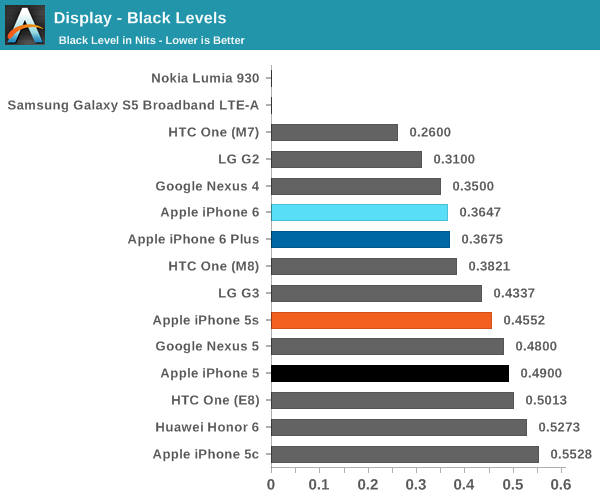

Now that we’ve covered the other two, we can talk about contrast. For this test, we measure brightness of 100% white and black at maximum display brightness, and look at the ratio. While we’re looking into getting patterns that can’t be defeated by dynamic contrast/backlight this should give an idea of best case contrast. In this case, peak brightness is on the high side at 560 nits, with relatively low black brightness at about a third of a nit. The result is one of the best contrast ratios I’ve ever seen. While the HTC One (M7) has a 1743:1 contrast ratio in our tests, some testing I’ve done indicates that the true contrast ratio is realistically around that of the One (M8). I’m not quite sure how this was done, but Apple stated that a new deposition process was used for the liquid crystals. This, along with changes to the liquid crystals themselves, could be responsible for the improved contrast.
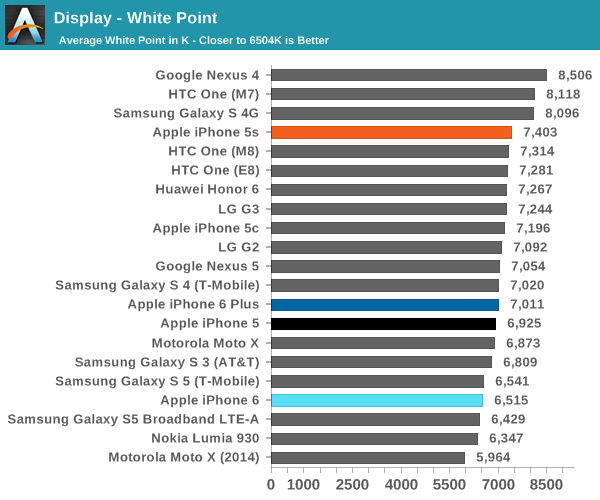
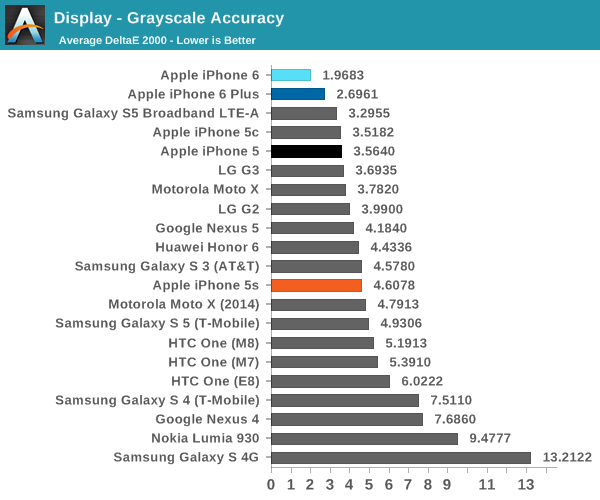
The next part to talk about is grayscale, which is an area where Apple seemed to prefer bluer color balances. I don’t really have much to pick at here, because the level of calibration here is incredible. While there is a noticeable trend of overshooting red at the low end and undershooting red at the high end, this is nitpicking at best. At any rate, this is essentially perfect.
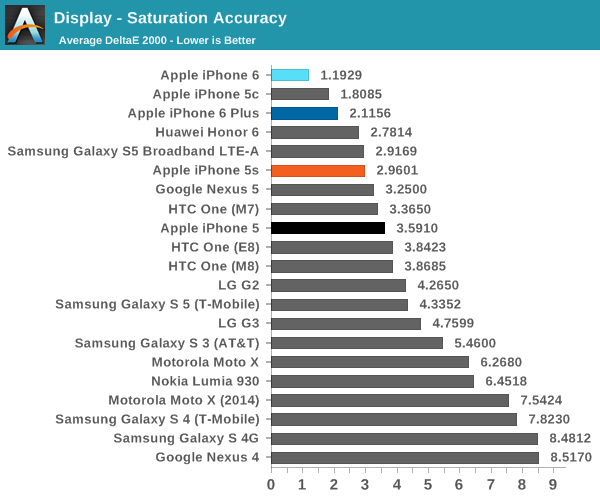
Our next test is the saturation sweep, which tests each primary and secondary color for accuracy in hue and luminance. While it’s true that humans can be relatively insensitive to differences in saturation, it is all too common to see OEMs artificially compress saturations to have vivid colors and be able to claim that they have an accurate display because it matches the sRGB gamut. In this test, the iPhone 6 sets a new record. I really don’t have any objections here because a dE2000 value of 1.19 is a deviation that is almost impossible to notice.
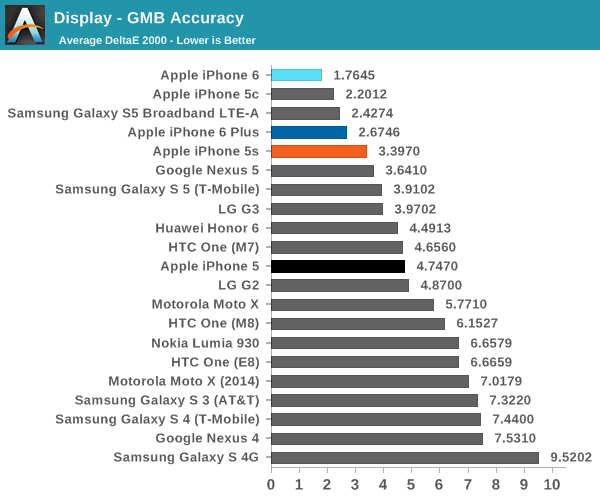
The final test is the Gretag MacBeth ColorChecker, which tests various hues and is usually one of the hardest tests to perform well in. In this regard, the iPhone 6 once again sets a new record for accuracy. This display is effectively calibrated to sRGB, and one would be hard pressed to find a significant deviation when compared to a reference monitor.
Overall, it’s hard to find any criticism for this display. I would normally be incredibly suspicious to see these numbers on a smartphone, but the fact that there’s a hot pixel in the center of the display suggests to me that this was not a cherry-picked unit. The fact that I find this level of calibration to be suspicious speaks volumes about how good this display is. While contrast isn't AMOLED levels of black, there are no purple smearing effects, noticeable uneven luminance near black, or any other idiosyncrasies.


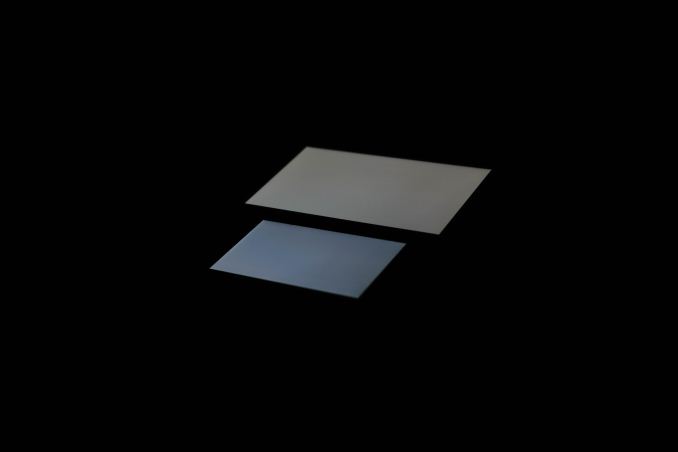
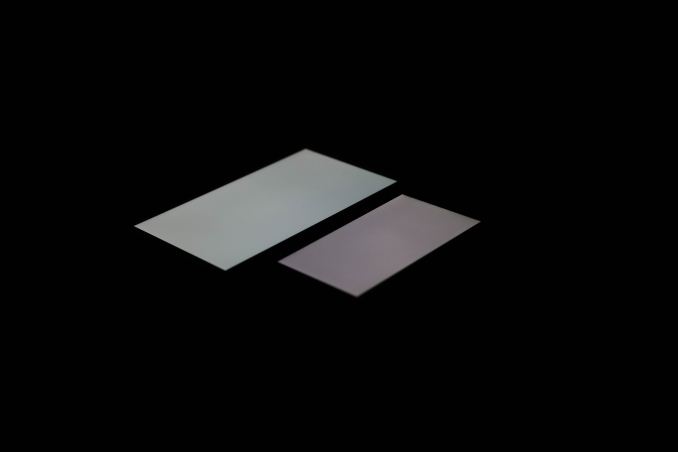
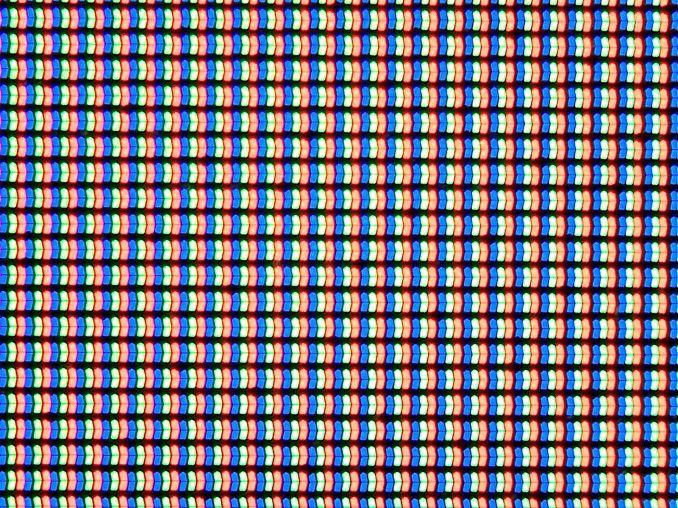
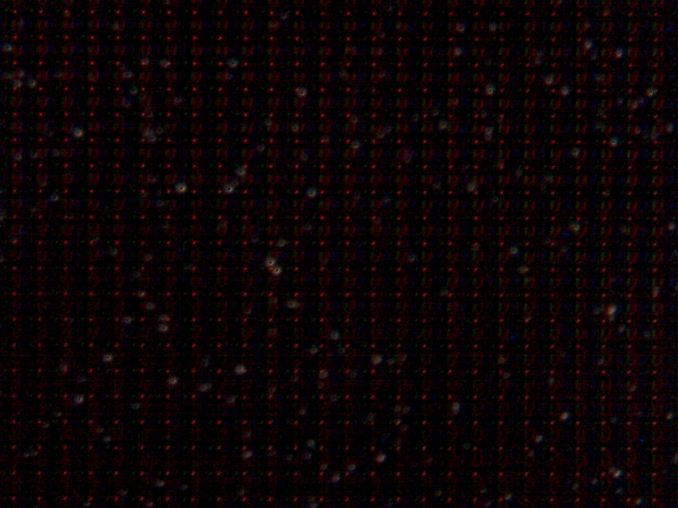
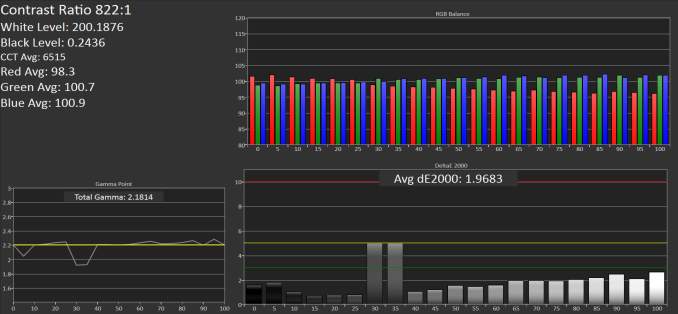

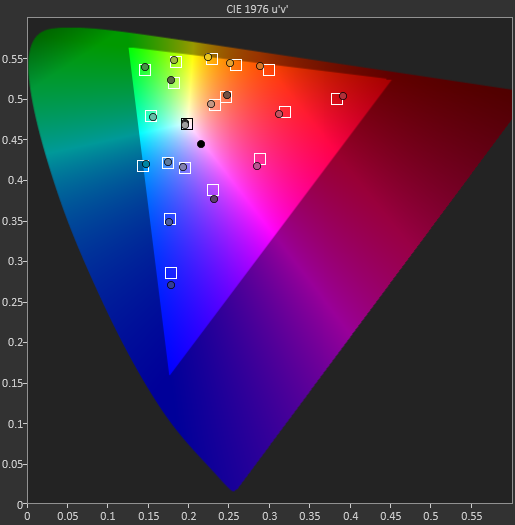








531 Comments
View All Comments
Toss3 - Wednesday, October 8, 2014 - link
Just because some people question the integrity of a website claiming to do objective measurements of a device's performance, doesn't mean that they are idiots. Quite the opposite in fact. It would be great if Anand changed the way they do their battery measurements (they do not reflect reality, and aren't comparable to other sites' results (should already be enough for them to question the way they do it)), and also dropped the browser benchmarks from the CPU performance section (browser performance != cpu performance, unless both phones are running the exact same version of the browser on the same platform (we know that chrome on iOS isn't the same as Chrome on android etc.)). And measuring the display brightness when setting the brightness manually also isn't ideal, as Samsung limits the peak brightness on their devices for those occasions, which means that the true peak is a lot higher (setting the brightness to automatic solves this issue(think quite a few people prefer auto to manual)).Toss3 - Wednesday, October 8, 2014 - link
Forgot to add that it would be great if they included a reference for the photo and video comparisons (D800 + color correction). There's also a big discrepancy between the time the photos were taken (around 8pm for all androids and 10pm for the iPhones (why is that?)).tralalalalalala40 - Wednesday, October 8, 2014 - link
To make it harder for the iphones under lower lighting to make the test more fair to droid phones.Toss3 - Thursday, October 9, 2014 - link
Lighting conditions should always be equal for all devices, and sometimes 10pm can be brighter than 8pm.tralalalalalala40 - Wednesday, October 8, 2014 - link
Samsung has to limit the brightness or else the pentile pixels will burn out quickly...How should they do the battery measurements? Apple has the most efficient SOCs and are destroying default QComm chips everyone is using.
Toss3 - Thursday, October 9, 2014 - link
Automatic brightness and normal usage would be best (playing a game for 2h - calling someone for 1h - browsing the web for 1h - installing 30apps, etc.). Being on both wifi and lte throughout the day.Toss3 - Thursday, October 9, 2014 - link
And the Exynos 5433 would like to disagree - currently on the launch firmware and already outscoring everything else (Geekbench scores over 1300/4300 and gfxbenchmark/sunspider numbers that match those of the iPhone 6). The 3DMark numbers are also higher than those of the iPhone 6.taehoon - Wednesday, October 8, 2014 - link
I want to know iphone6/6+ NAND performance test is based on 64 or 128GB.Because It is extremely higher than any other devices
Toss3 - Wednesday, October 8, 2014 - link
Why are you still running browser benchmarks when testing the CPU? You'd think that a site like Anandtech would know better (the difference between Samsung's own browser and Chrome is huge http://forum.xda-developers.com/showpost.php?p=557... How about running something like 3D Mark's physics benchmark instead? Basemark is a lot better than browser-based ones, but do we know if the benchmark performs equally on both platforms.tralalalalalala40 - Wednesday, October 8, 2014 - link
People commonly use the web browser on the device to browse the internet with their phone. Their other tests cover the 3D physics (which the iphone doesn't excel at, since most if the users of this phone aren't simulating physics problems).iPhone 6 is destroying the competition at the moment, samsung just dropped 10% in profits, they have to go back to making RAM, this might be their last high end phone release on android, they need to move to tizen.